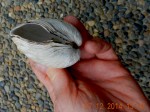
This image was taken after two walks on half of Taylor beach after a set of swells from the East in the past week. G. Fletcher photo.
It may not be obvious to the casual beach stroller, but the bits and pieces of plastic rope one sees occasionally can be a real hazard in the ocean. When the plastic breaks down ( It never really breaks down, it just turns into smaller pieces) it can be taken up into the gills of fish and invertebrates, where it can eventually become lethal.
Rather sad when you know that all these pieces of rope could have been disposed of properly instead of just being thrown carelessly into the ocean.
Solution: require all plastic rope used in the marine environment to be completely biodegradable after a certain length of time in the water or on a beach.
An additional insideous problem here is the small ring band of white plastic strapping on the right . This kind of band used in bundling fishing nets is what we see impaled on the necks of sealions.
Check out images of the results on the Race Rocks website .
Also see Entanglement
Interesting Reference: http://5gyres.org/ on Plastic Pollution Accumulating in Oceanic Gyres.























